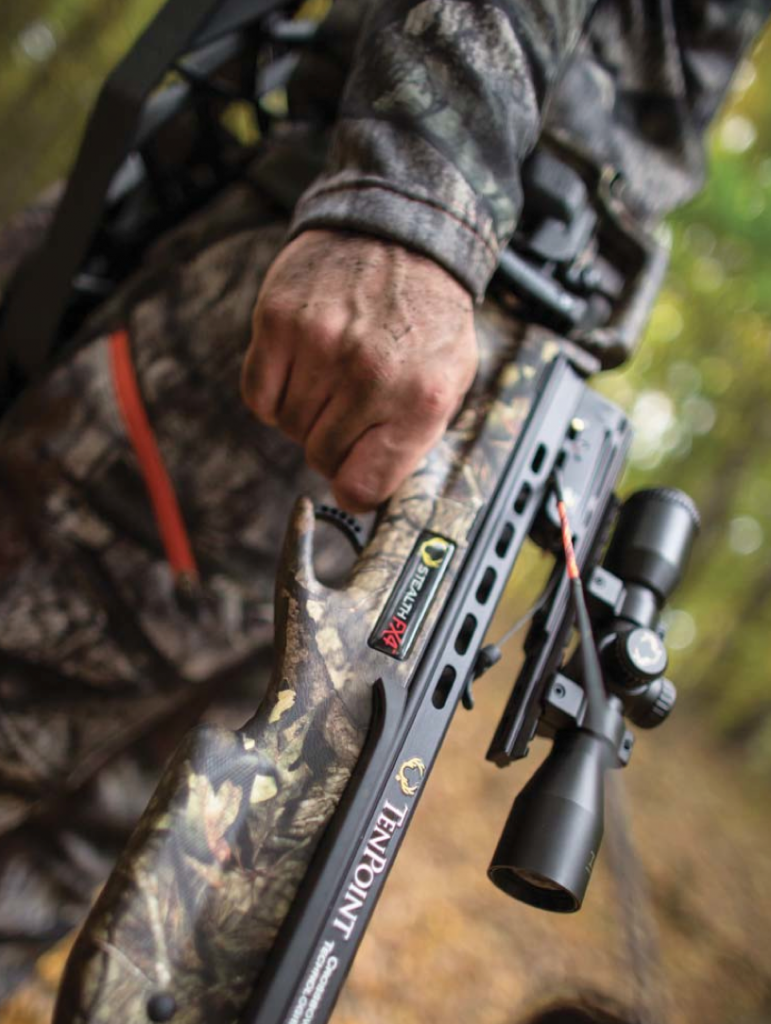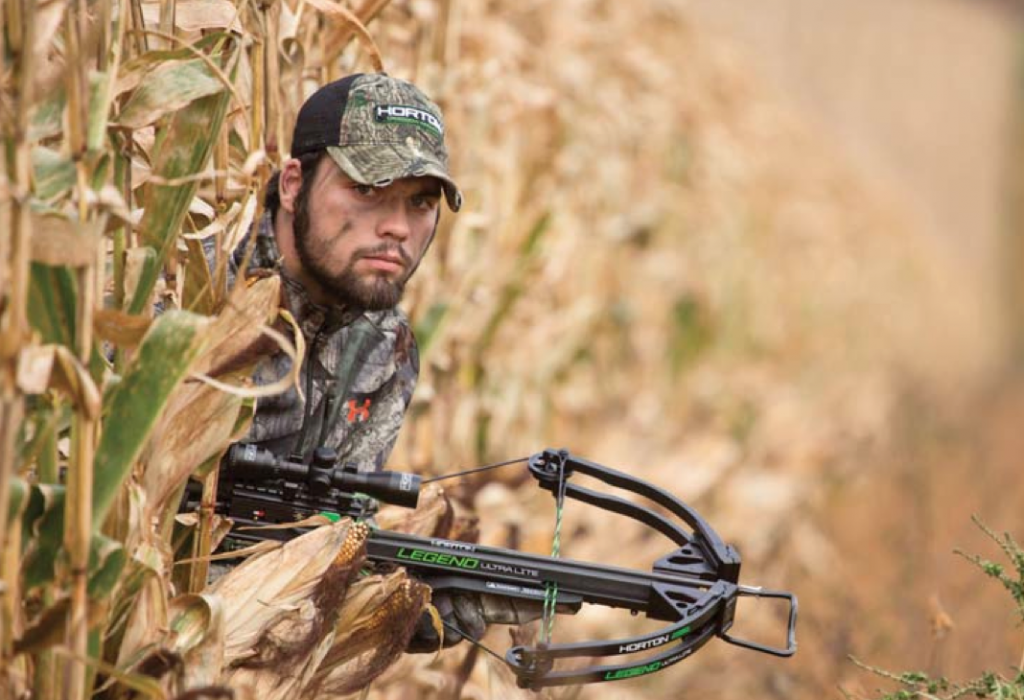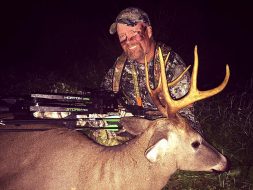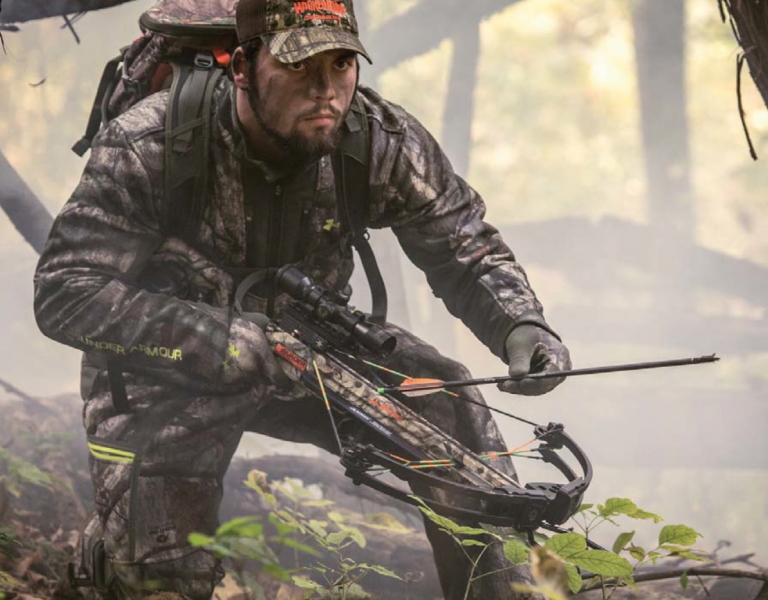We hunt in the conditions we get: rain, sleet, snow and bone-chilling cold, or a mixture of any and all as the Mother Nature is seldom cooperative, especially during the rut, when whitetails are most active and odds are best for arrowing a mature buck. What- ever daybreak brings. Not because we necessarily prefer these less than ideal conditions, but because we are hunters, and it’s what we do.
It takes a toll on hunters and their equipment although harsh weather conditions can be productive. This is true of modern crossbows. While marvelously engineered and built from high-tech materials, inclement weather can cause poor function that can affect accuracy, and although far less likely, failure of the bow to operate. Fortunately, there are things that can be done to ensure crossbows
work as intended when the trigger is squeezed, regardless of what Mother Nature dishes out.
PROPER MAINTENANCE
Today’s crossbows are designed to be not only user friendly but highly functional. Compound models, the most popular type used, have a lot of moving parts and components that take a great deal of wear and stress. In order to perform properly and provide reliable service, those parts require routine and regular maintenance.
Every crossbow sold comes with an instruction manual and/or video that includes information on its proper use, maintenance and safety. This generally includes instructions for lubing the rail, waxing the string and cables on compound models and lubricating the trigger mechanism and on compound bows, the cam axles. Neglecting any of this will, over time, affect proper function of the bow, lifespan of the various components and accuracy, particularly when hunting in extremely cold weather conditions.
Lubing the rail and waxing the string and cables should be done on a fairly regular basis. Lube should be applied on each side of the flight rail, ideally in the middle, using the fingers to spread it evenly along the entire length of each rail. On compound bows it is also important to lubricate the cam axles.
Apply wax to the string and cables, rubbing them between the thumb and index finger to generate heat, which helps the wax to penetrate. If you’re unsure of how often to wax and lubricate you bow, read the owner’s manual or contact the manufacturer.
Personally I make it a general rule to inspect and clean the flight rail and trigger mechanism before each hunting season, typically before September or October. This has proven sufficient during late December and January hunts, even after hunting in foul weather and when temperatures fall like a rock and stay there for days. Most of us get only one or two shots at whitetails each season, but even if the shot count is doubled or tripled the earlier applications are enough to ensure proper bow function.
During my years of hunting with a crossbow, I have yet to have one fail to fire due to extreme cold, but I maintain my bows per manufacturers’ recommendations. The biggest problem when it occurs is with the trigger box. Most are pretty well sealed except near the trigger, safety latch and string latch area. If temperatures drop after a period of rain or drizzle, or if sleet or snow seeps into the box and freezes, bad things can happen.
In such cases, clean the trigger box thoroughly, concentrating on the safety latch, anti dry fire mechanism and string latch. Apply lubricant to each and work the safety latch back and forth to work the lube in. If the trigger box gets excessively wet, or if icing seems to be the issue, spray the box thoroughly first with WD-40 to displace any moisture and allow it to dry before lubricating. Finally, inspect the flight rail track and channel for any debris or obstructions.
All of this takes just a few minutes, but wax and lubricant not only extend the life of the crossbow, they help repel water and ice from forming in cold temperatures and ensure the bow will operate when needed, even in harsh weather conditions.

BUT NOT TOO MUCH
The trouble with many crossbow owners is they don’t maintain their bows enough — or too much. Overkill on wax or lubricant, particularly in extreme cold conditions, can be nearly as bad as not enough. Most manufacturers recommend a waxing and a certain amount of lubricant after a certain period of time or after so many shots. In most cases, just enough wax to keep the strings and cables supple and a drop of lubricant is sufficient.
Any less than what is recommended affects crossbow longevity and performance, but too much has the potential of doing the same thing, especially after long periods in sub-zero temperatures. Some waxes and lubricants can actually stiffen on the rails or congeal to the point that arrow speed, and therefore accuracy, is affected. Because they have been especially developed and formulated for crossbows, only wax and lubricants recommended by the manufacturer should be used.
SOME HELPFUL TIPS
All things considered, today’s crossbows are marvelous, reliable hunting instruments that will not
only provide years of reliable service but do it in all weather extremes. While freeze-ups are rare when bows are properly maintained, they can and do occur. But there are a number precautions that can be utilized in worst case scenarios.

It’s a good idea to check the safety mechanism before heading out into the cold. Since the safety, trigger, string latch and anti-fire mechanism are internally connected, if the safety latch works freely and properly, chances are good everything else will work as well. Another thing to take note of is when cocking the bow you should hear a solid “click,” indicating the string is securely latched. And when you let off on the rope cocker or mechanical cocking device do so slowly, maintaining pressure and a solid grip just in case the string latch doesn’t hold.
One of the best investments you can make regardless of the season — because rain is always a possibility — but particularly for the late and cold seasons when snow and ice are almost a given, is an umbrella. Not the type you might keep in the car for rainy days, but a hunting umbrella, available at most retail outlets that sell hunting gear. They are inexpensive, easily carried in a pack when disassembled, are easy to erect and can help make an utterly miserable day tolerable, while providing protection to both hunter and crossbow.
My pack is never without one. My favorite measures 54 inches across, more than large enough to provide protection for me and my bow when it’s raining, snowing or sleeting. They also serve as a handy wind break and can be used as a portable blind. I have one that screws securely into a tree trunk.

Whether I’m sitting close to the ground or in an elevated stand, it wraps snuggly around the tree, the top held in place by an adjustable strap. I also own one that straps to a tree top and bottom, and can be used on pubic hunting areas where screwing anything into trees is prohibited, or on private ground where the landowner frowns on this, too.
Pop-up blinds are another way to beat the elements. While they aren’t 100 percent waterproof, but they do a decent job of keeping the hunter and crossbow reasonably dry in a drizzle, moderate downpour or during a snow squall or storm. Blinds also provide shelter from the wind. On a cold, wind-swept day, it can feel several degrees warmer inside a blind. I have several set up on my property all through the season and though I prefer to hunt from nearby stands for greater visibility and more shot opportunities, there have been days when the blinds have provided welcomed shelter.
In snow, sleet or rain, protection to the trigger box area can be provided by covering it with gloved hands. I wear waterproof gloves, which adds an extra degree of protection. And on super cold days I insert hand warmers for added comfort. Although little heat is generated outward, just the gloves over the trigger box can prevent possible freeze-ups.
While walking into my hunting area, or while hunting in extremely wet, snowy or sub-freezing conditions, holding the crossbow on its side with hands positioned over the trigger box also helps prevent snow, water and ice from accumulating on the flight rail and in the barrel groove. After arriving at my destination and settling in, I gently wipe my hand along the flight rail before seating an arrow, to make sure it is free of ice, snow or other obstacles.
As troublesome as rain, snow and ice can be, on clear, cold days condensation can form everywhere, including on stocks, scopes and inside, as well as outside a crossbow’s trigger box. This condensation is created when objects exposed to cold temperatures are suddenly warmed, such as when you bring a crossbow into a warm house or camp after a day in near-freezing temperatures.
To prevent condensation from forming and therefore negating the necessity of a thorough drying and re-lubrication, it helps to keep the bow at somewhat of a uniform temperature. With that in mind, I have gotten in the habit of stowing my bow in my unheated garage at home, on the porch at camp or in my locked pickup during cold days with no precipitation.
Some hunters I know prefer recurve crossbows in extreme weather conditions, their reasoning being that with fewer moving components, there is less that can freeze up and cause problems or malfunctions. While that is basically true, both recurve and compound crossbows have a trigger box. And since it is the trigger box that seems to be the cause of most problems, it is difficult to follow their logic that less is better.
Properly maintaining your crossbow per manufacturer’s recommendations, making sure everything works properly before heading for the woods and limiting moisture of any kind from accumulating or freezing on the bow, are the true keys to making sure your bow will perform as expected and required in extreme weather conditions.
Finally, scopes can affect accuracy during periods of inclement weather. Rain drops or snow and sleet that has accumulated or melted on the eye piece can distort the image, and effect range estimates and arrow placement. For that reason lens covers, easily and quietly removed when the time comes to shoot, can be a valuable asset for keeping scope lenses clear and making that shot count.

